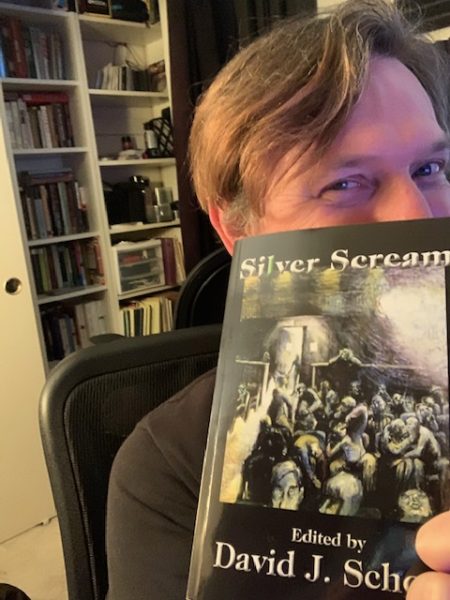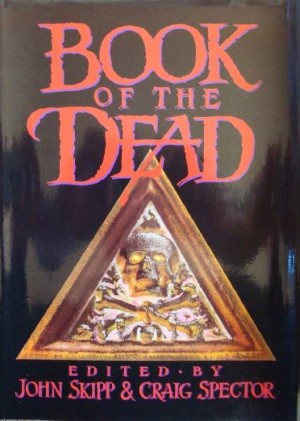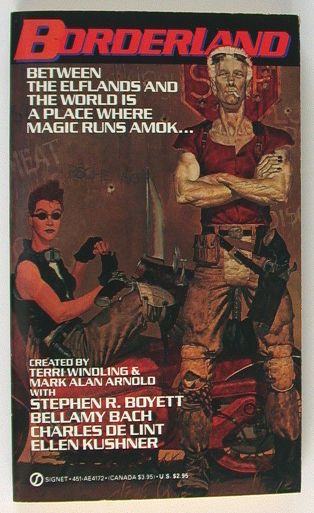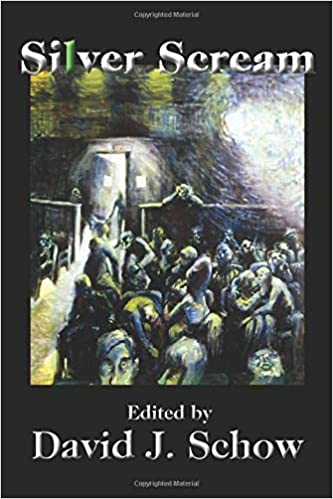 Dave Schow’s massive movie-industry-themed 1988 horror anthology Silver Scream has been reprinted by Cimarron Street Books. I have a story in it, so yay!
Dave Schow’s massive movie-industry-themed 1988 horror anthology Silver Scream has been reprinted by Cimarron Street Books. I have a story in it, so yay!
Dave is credited with inventing the word splatterpunk to describe a movement of younger writers in 80s horror that tended more toward the cinematic than the literary, more punk than progressive, more grindhouse than arthouse. Silver Scream made a splash–nominated for the World Fantasy Award, very favorably reviewed, a core-sampling of the 80s horror landscape, and containing some stories that became much-reprinted classics, such as Joe Lansdale’s “Night They Missed the Horror Show” and Robert McCammon’s “Night Calls the Green Falcon,” not to mention director Mick Garris’ first published short story, “A Life in the Cinema.” It’s generally considered to be one of the two definitive splatterpunk anthologies.
I hadn’t published much that would be considered any type of horror, much less splatterpunk, but I was friends with a whole bunch of horror writers, and I relished the opportunity to hang with them in books, too.
But I knew I couldn’t compete with them in terms of sheer goosh. They were scary and icky for a living. Luckily, I had worked as a word-processing operator (a Brand New Thing back then) for the University of Florida History and English departments, and I typed more academic exegeses than you can imagine. We’re talking books in 12th Century Merovingian Latin (hi, Dr. Geary!), Freudian analysie of horror archetypes as social behavior templates (hi, Dr. Twitchell!), post-structuralist grammatological examinations of lard-and-felt sculptures as illuminations of feminist criticism (you think I’m making this up, don’t you?).
So I was in a perfect position to write a horror story about academic film criticism. “The Answer Tree” is about a film critic at a rare screening of a legendary horror movie so subliminally seductive that it kills people. It’s a serious version of the Monty Python “killer joke” skit performed as a mashup of surrealist biography and iconography involving Cocteau, Bunuel, Dali, Lynch, and others. The challenge wasn’t to move the plot toward some Big Reveal about the movie killing someone, it was to chart the movie’s unfolding, supplemented with excerpts from fictitious academic works about the director, in a way that showed you how that process might happen.
“The Answer Tree” created an entirely fictitious film career and oeuvre that seemed genuine. I’m gauchely proud of it, and very glad it’s back in print.
I’ve been very lucky regarding anthologies. I haven’t published in many, but some of them have been considered influential, even landmarks. Silver Scream was one.
My novella “Like Pavlov’s Dogs” was included in the other definitive splatterpunk anthology, John Skipp & Craig Spector’s very loud, gooshy, popular, and influential 1989 Book of the Dead. It was the first zombie anthology, a shared-world anthology that takes place in George Romero’s zombie universe (with an an intro from Romero). It’s been credited with playing a role in the, um, rebirth of the modern zombie genre (unbelievably still, um, alive).

BotD was a cross-section of 80s horror writers, and I was delighted when John Skipp invited me to write something for it. Given the company I was keeping, I was thrilled when John told me he thought that the violence and death in “Pavlov” was very disturbing because it was so personal.
Though it was commercially and critically popular, BotD has a checkered history. Skipp and Specter’s agent sold its foreign rights and never paid anyone a dime, then made off with a not-insubstantial amount of royalties. Despite the book being something of a landmark, no one in it made a dime in royalties. I’ve never even seen one of the foreign editions. And Craig Spector tried to sell a reprint to White Wolf Press under another title without even notifying the contributors, much less paying us, which initiated some very colorful letters (this was before email) and threats of grievous bodily harm. I remain mystified why anyone chooses writing as a career. But I’m still delighted to have been a part of BotD.
My novella “Prodigy” was the lead story in Terri Windling’s 1986 Borderland anthology, which generally has been regarded as one of the originating examples of what became known as Urban Fantasy (though the perception of Urban Fantasy itself has changed a good bit over time).

I have to admit that “Prodigy” is an odd fit in the anthology. I think Terri wanted Borderland to have a sort of Manhattan-meets-Faerie feel, and I set my story in a fantasy-postapocalyptic Los Angeles that seems to better fit the Change milieu of my novels Ariel and Elegy Beach (so much so that I allude to “Prodigy” in the next Change novel, Avalon Burning).
But I was flattered to be asked to contribute, and glad to be part something so often cited as making an impression on many young readers of fantasy.
